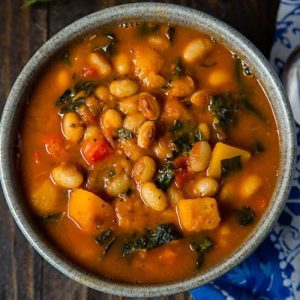This hearty White Bean Stew with Winter Squash and Kale is a comforting, nutrient-packed meal that’s perfect for cozy evenings or meal prep.
Bursting with fiber-rich beans, vitamin-packed squash, and iron-rich kale, it delivers plant-based protein and low-fat nutrition in every bowl.
Quick, simple, and full of flavor, it’s an everyday recipe that satisfies both body and soul.

Healthy Butternut White Bean Stew
Equipment
- 1 large Dutch oven or pressure cooker
- 1 cutting board
- (1) Chef’s knife
- 1 measuring cup
- 1 measuring spoon
- 1 Wooden spoon or spatula
Ingredients
- 1 lb dried yellow-eye or navy beans soaked overnight or quick-soaked
- 1 large onion chopped
- 4 cloves garlic minced
- 5 cups water
- 4 tsp smoked paprika divided
- 2 tsp dried oregano divided
- 1 ½ tsp ground cumin divided
- 1 tsp dried basil
- 1 lb winter squash or pumpkin peeled and diced into ¾-inch cubes
- 1 large red bell pepper chopped
- 1 jalapeño pepper seeded and finely chopped (optional)
- 1 15-ounce can diced tomatoes, fire-roasted preferred
- 1 tsp salt or to taste
- 1 bunch kale stems removed and sliced (about 12 ounces)
- 1 cup fresh or frozen corn optional
- ½ cup fresh basil chopped
Instructions
- Prepare the Beans: Start by carefully rinsing your dried beans under cold water, removing any debris or small stones that may be mixed in. To ensure even cooking and a creamy texture, soak the beans overnight in plenty of cold water. If you’re short on time, you can quick-soak them: bring a pot of water to a boil, add the beans, boil for one minute, then remove from heat, cover, and let them sit for at least an hour. After soaking, drain the beans and set them aside.
- Chop the Aromatics: Peel and finely chop one large onion and mince four cloves of garlic. These aromatics are the flavor foundation for your stew. Set them aside in a small bowl so they’re ready to sauté. If you like a little extra depth, sprinkle a pinch of baking soda over the onions when cooking—it helps them brown faster and develop a slightly sweet, caramelized flavor.
- Sauté the Onion and Garlic: Heat a large Dutch oven or the sauté function of your pressure cooker over medium heat. Add a splash of water or a small amount of oil if desired, then add the chopped onion. Cook gently, stirring occasionally, until the onion softens and starts to turn golden brown. Once the onions are translucent and fragrant, add the minced garlic and sauté for an additional minute until aromatic, taking care not to burn it.
- Add Beans and Spices: Add the drained beans to the pot along with 5 cups of fresh water. Stir in 2 teaspoons of smoked paprika, 1 teaspoon of dried oregano, 1 teaspoon of ground cumin, and 1 teaspoon of dried basil. These spices infuse the beans with a warm, smoky, and herbaceous flavor.Stir everything together gently, ensuring the beans are fully submerged in water for even cooking.
- Cook the Beans: For Pressure Cooker: Seal the lid and bring to high pressure. Cook for 8 minutes, then perform a quick release of the pressure according to your device instructions.For Stovetop: Bring the pot to a boil, then reduce heat to low, cover, and simmer gently. Check periodically, adding more water if needed, until the beans are just tender. Depending on your beans and water hardness, this may take between 30 minutes and 1.5 hours.
- Prepare the Vegetables: While the beans cook, prepare the rest of your vegetables. Peel and dice 1 pound of winter squash or pumpkin into ¾-inch cubes. Chop 1 large red bell pepper and, if using, finely chop 1 jalapeño pepper for a gentle heat. Keep these prepped vegetables close at hand—they’ll go in as soon as the beans are ready.
- Combine Vegetables and Remaining Seasonings: Once the beans are nearly tender, add the diced squash, chopped peppers, 1 (15-ounce) can of fire-roasted diced tomatoes, the remaining 2 teaspoons of smoked paprika, 1 teaspoon of oregano, ½ teaspoon of cumin, and 1 teaspoon of salt (or to taste). Stir gently to combine, making sure all the ingredients are evenly distributed.
- Cook Vegetables Until Tender: For Pressure Cooker: Seal and cook at high pressure for another 8 minutes. Allow the pressure to release naturally for 15 minutes, then perform a quick release if needed.For Stovetop: Cover and simmer the stew over low heat, checking occasionally, until the squash is soft and easily pierced with a fork, usually about 15–20 minutes. Add extra water if necessary to keep the stew at your desired consistency.
- Add Kale and Optional Corn: Once the squash is tender, stir in 1 bunch of sliced kale and 1 cup of corn if using. Cover the pot and simmer for an additional 5 minutes, just until the kale wilts and the corn is warmed through. This keeps the greens vibrant and tender, without overcooking.
- Finish with Fresh Basil and Taste Adjustment: Remove the stew from heat and stir in ½ cup of freshly chopped basil. Taste the stew and adjust seasonings as needed—add more salt, smoked paprika, or cumin to enhance the depth of flavor. The fresh basil at the end gives a bright, aromatic lift that complements the rich, earthy beans and sweet squash.
- Serve and Enjoy: Ladle the stew into bowls, making sure each serving gets a balanced mix of beans, squash, kale, and sauce. This stew is hearty enough to enjoy on its own, but it also pairs beautifully with crusty bread, quinoa, or brown rice for a complete meal. Store leftovers in an airtight container in the refrigerator for up to 4 days, or freeze portions for meal prep.
Notes
- Soaking beans overnight helps them cook evenly and reduces digestive discomfort. Quick-soak works in a pinch but may require slightly longer cooking.
- Use fire-roasted diced tomatoes for added depth of flavor; regular tomatoes work fine but give a milder taste.
- Winter squash varieties such as butternut, acorn, or kabocha all work; choose firm, evenly colored squash for the best texture.
- Adjust the spice level by including or omitting the jalapeño pepper.
- Kale can be swapped with Swiss chard or spinach, though cooking times may vary.
- This stew improves in flavor the next day, making it ideal for meal prep.
Chef’s Secrets: Maximizing Flavor and Texture
To get the richest flavor, always sauté the onions and garlic until they are golden and fragrant before adding beans.
A pinch of baking soda can accelerate caramelization and create a sweeter, deeper base.
Layering spices in two stages—half with the beans and half with the vegetables—ensures the flavors develop fully.
For extra creaminess, mash a few beans at the end with the back of a spoon.
Using fresh basil at the last step adds brightness, balancing the smoky paprika and earthy squash beautifully.
Serving Suggestions: Pairing Ideas and Enhancements
Serve this stew as a wholesome, standalone meal for lunch or dinner.
For a heartier plate, accompany it with crusty whole-grain bread, quinoa, or brown rice to soak up the savory broth.
Garnish with a drizzle of olive oil or a sprinkle of nutritional yeast for extra flavor and richness.
A side of roasted vegetables or a simple green salad complements the stew’s hearty texture while keeping the meal light and satisfying.
Storage Tips: Keeping Stew Fresh Longer
Store leftover stew in an airtight container in the refrigerator for up to four days.
To reheat, gently warm on the stovetop or microwave, adding a splash of water if it has thickened.
For longer storage, freeze portions in freezer-safe containers for up to three months.
Thaw in the refrigerator overnight before reheating.
If the kale has darkened during freezing, stir in a handful of fresh greens before serving to refresh color and texture.
Frequently Asked Questions
1. Can I use canned beans instead of dried beans?
Yes, canned beans work well and reduce cooking time significantly.
Use about 3 cups of drained, rinsed canned beans in place of 1 pound of dried beans.
Reduce the initial water and adjust cooking time so the beans don’t become mushy.
2. Is this stew suitable for a vegan diet?
Absolutely! This recipe is plant-based, gluten-free, soy-free, and free from added sugar.
It’s a nutrient-dense vegan option, providing protein, fiber, and vitamins from whole foods.
3. Can I substitute the kale with another green?
Yes, spinach, Swiss chard, or collard greens are excellent alternatives.
Keep in mind that spinach cooks faster and should be added near the very end to prevent overcooking.
4. How can I make this stew spicier or milder?
For more heat, keep the jalapeño seeds or add a pinch of cayenne pepper.
To reduce spice, omit the jalapeño entirely or remove the seeds. The stew remains flavorful and comforting either way.
5. Can I make this stew ahead of time for meal prep?
Definitely. The flavors actually improve after sitting for a day, making it ideal for meal prep.
Store in individual portions in the fridge for up to 4 days or freeze for longer-term meals.
Reheat gently and stir in fresh basil or kale if desired before serving.

